
Pages:
<< Back 6
7 8
9 10
11 12
13 14 15
Next >>
A
more radical innovation was the addition of competence requirements
for graduation from both the College of Liberal Arts and the School
of Nursing. Three areas of competence were identified: writing,
quantitative reasoning, and oral communication. Students were required
to demonstrate competence in each of these in various ways, including
passing courses in regular departmental subject areas. These courses
were designated for that purpose by the letters W (writing), Q (quantitative
reasoning), and S (speaking) to indicate the appropriate competence.

__________________________________
Freshmen take an orientation examination in
Bowman Gymnasium.
______________________________________
In 1979 the DePauw Honor Scholar program was introduced, offering
special opportunities for intensive intellectual experience to 20
carefully selected freshmen each year. Members of each honors class
enroll in a cross-disciplinary seminar during the first four semesters
and in the last two years pursue independent study culminating in
an honors thesis prepared under the direction of one or more members
of the faculty. The organizer and first director of the program
was Robert E. Calvert of the political science department. Other
faculty members assisted in the program from the beginning, and
in 1985 Eugene Schwartz of the chemistry department succeeded Calvert
as director.
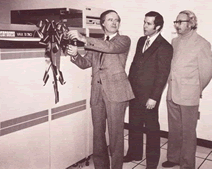
_______________________________________
President Richard Rosser, along with Carl Singer, director of
academic computing, and Robert Thomas, professor of mathematics and
computer science, celebrate more computer equipment, a VAX 11/780.
______________________________________
The Center for Management and Entrepreneurship came into existence
in 1980 to "prepare liberal arts students for leadership roles
in private and public sector management and to encourage the spirit
of entrepreneurship." Among the center's activities have been
an executive-in-residence program that brings business leaders to
campus for presentations and round-table discussions, a series of
symposia, and an annual Small Business Conference. The center also
supervises the DePauw Management Fellows program for exceptional
students planning careers in management, either in large corporations,
small business firms, or non-profit organizations. Its directors
have been John S. McConnell, Charles R. Tilden, and B. Thomas Boese.
Vincent Serpa of the Romance language department was acting director
in 1985-86 and assistant director for the following year.
Two unfinished construction projects reached completion in the early
part of the Rosser presidency. A campaign headed by Trustee Ardath
Burkhart to raise funds for the restoration of East College culminated
in the bequest of an estate valued at $2.7 million from alumnus
Philip St. John Charles in memory of his parents and his sister,
Emilie Charles, also a DePauw graduate. The bulk of it was designated
for the restoration of East
College. A gift from alumna Caroline Hughes Crummey in honor
of her father, Edwin Hughes, former DePauw president and Methodist
bishop, went toward the restoration of Meharry Hall.
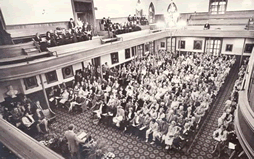 
Under the direction of Indianapolis architects H. Roll McLaughlin
and Forrest Camplin the majestic old building was meticulously refurbished
and restored to approximately its original appearance, but with
the addition of such modern appurtenances as wall-to-wall carpeting,
air conditioning, and an elevator. In Meharry Hall, the structure's
centerpiece, the organ was removed from the stage, which was itself
restored to the smaller size and curved front seen in early illustrations,
and a replica of the small balcony that originally extended over
the stage was built. The elimination of the iron fire escapes from
the outside wall at the rear of the hall, however, led to a fire
marshal-imposed ban on occupation of the distinctive sloping balconies
favored by freshmen in the old daily chapel days.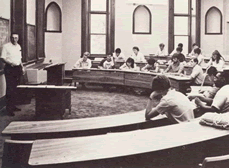

The new East College
also contained remodeled classrooms, faculty studies, the offices
of the Center for Management and Entrepreneurship, a Hall of Donors,
a faculty lounge, and the depository of the Indiana Journalism Hall
of Fame, established earlier by Sigma Delta Chi. The dedication
of the restored East College
on Old Gold Day 1981 was a celebration of the spirit of Old Asbury
in the midst of an extensive modernization of the DePauw University
campus.
The next year the Lilly Physical Education and Recreation Center
was completed at a cost of $7.2 million. Located just south of the
Julian Science and Mathematics Center it was designed by Herbert
R. Thompson of the Indianapolis architectural firm of James and
Associates and named collectively for Josiah K. Lilly Jr., Josiah
K. Lilly Sr., and Colonel Eli Lilly- the father, grandfather, and
great grandfather, respectively, of Ruth Lilly Van Riper, the chief
donor. The imposing structure contained a spacious fieldhouse, natatorium,
auxiliary gymnasium, and numerous smaller facilities, as well as
classrooms and offices for the coaching and physical education staff.
The fieldhouse itself was named in honor of Raymond "Gaumey"
Neal, who coached the famous championship football team of 1933.
Surviving members of the team contributed $2.3 million to its construction,
Chester Elson and Norman Frees of the class of 1936 each pledging
$1 million.
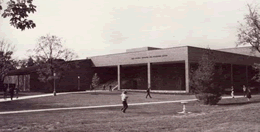 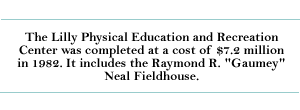
The razing of Music Hall and Bowman Gymnasium presented a unique
opportunity for the creation of a beautifully landscaped plaza in
the three-acre empty space between Hanna Street and the new Performing
Arts Center. Bowman Park, complete with a natural amphitheatre,
reflecting pool and fountains, curving walks, and a patio furnished
with tables and chairs for outdoor refreshment, came into being
in 1983. It provided an open-air recreational area located conveniently
near the center of the campus.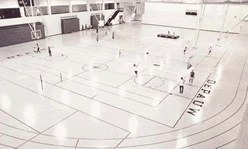

Other additions to the physical plant included the purchase of Charter
House from Gobin United Methodist Church in 1983 and the construction
of a new baseball field named for alumnus-athlete Merle "Ole"
Walker in 1984. Charter House provided a centralized location for
the offices of development, alumni affairs, public relations, university
publications, the news bureau, and summer conferences as well as
improved quarters for the university health services. The administration
also planned extensive remodeling of older university facilities,
especially Asbury Hall, Harrison Hall, and the Roy O. West Library.
The work on Asbury Hall was completed by the fall of 1986, while
the even more thorough refurbishing of the library extended through
the 1986-87 academic year and into the fall of 1987.
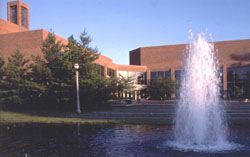
________________________________
A view across the pond with fountain in
Bowman Park at the Performing Arts Center.
____________________________________

__________________________________
Bowman Park on the site of Bowman Gymnasium
has become a favorite hangout for students,
who gather around the fountain in warm weather.
______________________________________
Back
to Top
Pages:
<< Back 6
7 8
9 10
11 12
13 14 15
Next
>>
|












